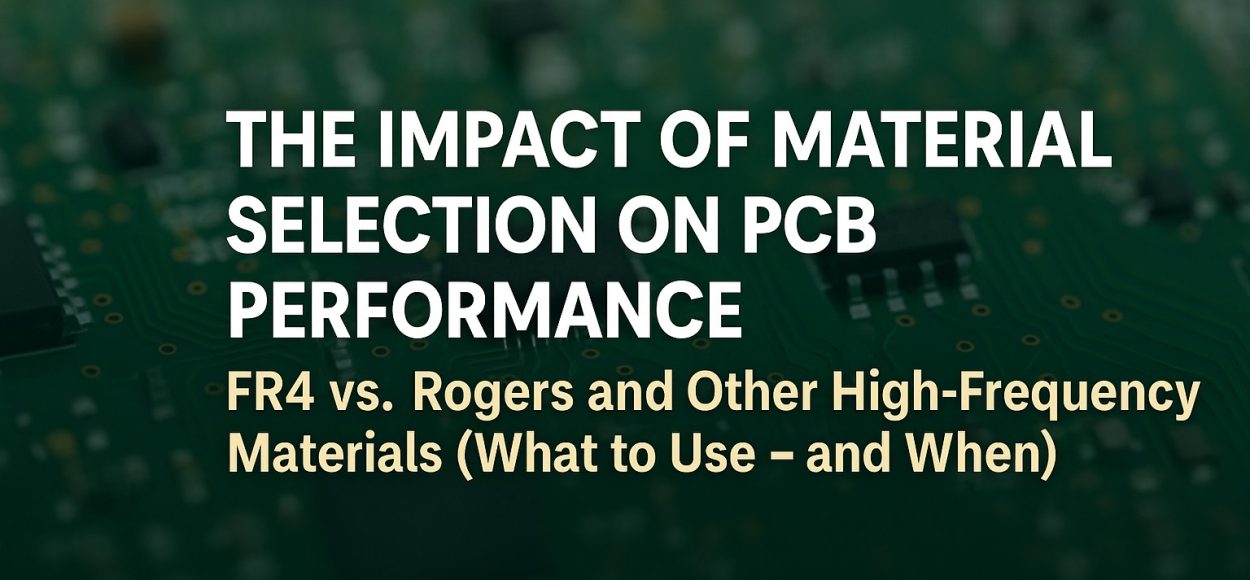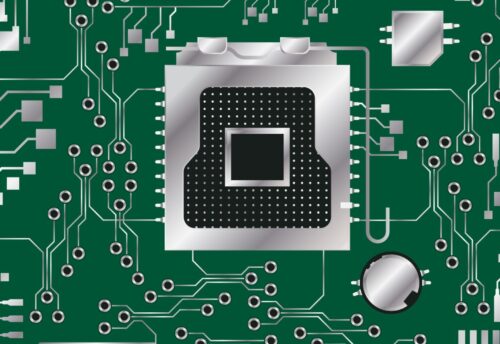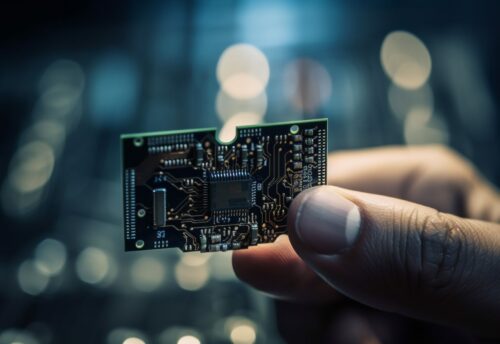
- September 24, 2025
- PCB Blog
The Impact of Material Selection on PCB Performance
FR4 vs. Rogers and Other High-Frequency Materials (What to Use – and When)
If your board is dropping bits at high speed, missing impedance targets, or getting too warm for comfort, the culprit might not be the layout – it could be the laminate. PCB material choice drives signal integrity, thermal behavior, reliability, and even your final BOM cost. In this guide, we’ll compare FR4, Rogers, and other high-frequency laminates, and share practical tips to pick the right stack-up for your next design.
Why PCB Material Selection Matters
A PCB is more than copper: the dielectric between layers defines how your signals travel and how your board endures heat, humidity, and time. Three attributes reign supreme:
- Dk (Dielectric Constant): Impacts signal velocity and trace geometry for a given impedance.
- Df (Dissipation Factor, “loss tangent”): Lower is better for high-speed/RF- less energy lost as heat.
- Thermal properties (Tg, Td, CTE): Affect stability during reflow and in the field.
When material goes wrong: higher losses at GHz rates, impedance drift with temperature, crosstalk increases, via stubs “ring,” and compliance tests fail.
FR4: The Dependable Industry Standard
What it is: Glass-reinforced epoxy laminate. It’s everywhere for a reason.
Strengths
- Cost-effective and widely available.
- Solid mechanical strength and moisture resistance.
- Great for mixed-signal products up to low-GHz (short links, moderate data rates).
- Fabrication is routine; predictable lead times.
Watch-outs
- Higher Df than RF laminates → more loss at multi-GHz.
- Dk variation across lots can loosen impedance control.
- Thermal and dimensional stability are good, not great.
Best fits: Consumer/IoT, industrial control, power management, most digital designs below ~3–5 GHz channel requirements.
Rogers: When High-Frequency Performance Matters
What it is: Engineered high-frequency laminates (multiple product families) optimized for low loss and stable Dk.
Strengths
- Low Df → cleaner eye diagrams and longer runs at GHz+.
- Stable Dk across frequency and temperature → precise impedance.
- Better thermal behavior for power/RF sections.
Watch-outs
- Higher material cost than FR4.
- Process nuances: press cycles, bonding films, drilling—choose a fabricator with real experience.
Best fits: RF/microwave, antennas, 5G infrastructure, radar, medical imaging, high-speed backplanes where margin is tight.
Other High-Frequency & Specialty Materials
PTFE / Teflon-based Laminates (e.g., PTFE glass, ceramic-filled PTFE)
- Ultra-low Df for microwave/mmWave.
- Outstanding for satellite links, 77 GHz automotive radar, and mmWave modules.
- Trade-offs: hardest to process, pricier, longer lead times.
Polyimide (including Flex)
- High temperature resilience and flexibility—great for flex/rigid-flex designs.
- Favored in aerospace, wearables, and medical patches where bending or thermal cycling is common.
- Loss is typically higher than RF laminates; used where mechanics > RF.
- Metal-Core PCB (MCPCB) Aluminum/copper core spreads heat for LED lighting, power supplies, motor drivers.
- Not about RF; all about thermal performance and reliability.
Hybrid Stack-Ups: The Practical Middle Ground
You don’t have to choose one laminate for the whole board. Many high-speed designs use hybrids:
- Rogers/PTFE on high-frequency layers for transceivers and sensitive lines.
- FR4 on power & low-speed layers to control cost.
- Requires careful bonding films and press cycles-work with a shop that does hybrids regularly.
Quick Comparison Table
| Property / Goal | FR4 | Rogers (HF) | PTFE (mmWave) | Polyimide (Flex) | Metal-Core |
|---|---|---|---|---|---|
| Loss @ GHz (Df) | Moderate/High | Low | Ultra-low | Moderate | Moderate |
| Dk Stability | Moderate | High | High | Moderate | n/a |
| Impedance Control | OK | Excellent | Excellent | OK | n/a |
| Thermal Endurance | Good | Good–Very Good | Good | Excellent | Excellent (heat spreading) |
| Cost | $ | $$–$$$ | $$$ | $$ | $$ |
| Best For | General digital/analog | RF, high-speed digital | Microwave/mmWave | Flex/rigid-flex, aerospace | Power/LEDs |
Practical Design Tips by Material
- FR4: shorten high-speed runs; add pre-emphasis/equalization margin; specify tight Dk/Df tolerance if possible.
- Rogers/PTFE: do impedance modeling early; share exact stack-up (dielectric thickness, copper weight) with fabricator; watch CTE for BGA via reliability.
- Polyimide/Flex: define bend radius and dynamic vs. static flex zones; avoid components in flex; add stiffeners; select coverlays carefully.
- Metal-Core: isolate sensitive analog/RF from the core plane; plan creepage/clearance for high-voltage paths.
Common Mistakes (And Easy Fixes)
- Choosing FR4 for a 10+ Gbps backplane → excessive loss.
- Fix: Move lanes to Rogers or shorten channels/add retimers.
- Specifying material late → layout rework when impedance fails.
- Fix: Lock stack-up & material before placement/routing.
- No hybrid experience at the fab.
- Fix: Work with a vendor that routinely builds hybrid and impedance-controlled boards.
How to Choose – A Quick Checklist
- What are my fastest nets (data rate, frequency)?
- Required impedance and loss budget?
- Environmental: temperature, vibration, humidity, bend?
- Thermal demands – do I need a metal core?
- Volume and cost targets?
- Does my fabricator have proven experience with the chosen laminate?
FAQs
Often yes for short, controlled links up to a few GHz, especially with good routing and equalization. For long channels or RF, step up to Rogers/PTFE.
Lower loss and stable Dk, which preserves eye openings and tight impedance at high frequencies.
When you’re in microwave/mmWave territory (e.g., radar, satellite) and every tenth of a dB matters.
Yes – hybrid stack-ups (Rogers on RF layers, FR4 elsewhere) balance performance and cost. Make sure your fabricator is experienced.
Use polyimide for flex sections, define bend radii early, and keep components off dynamic flex areas. Rigid-flex reduces connectors and improves reliability in tight spaces.
Usually yes. Expect longer procurement and qualification times; plan with your vendor early.
Final Thoughts
Material choice is a design decision, not a purchasing footnote. FR4 wins for cost and versatility, Rogers/PTFE win for high-frequency performance, polyimide wins for flexibility, and metal-core wins for heat. Many teams land on a hybrid to hit both performance and budget.
Work with a Fabricator Who’s Built It All
At Precision4PCB, we routinely build:
- Impedance-controlled FR4, Rogers, PTFE, and hybrid stack-ups
- Rigid-flex with polyimide, tuned for bend life
- Metal-core boards for power and lighting
- Engineering DFM reviews before you spend on a full run
Request a Free Quote or Speak to us – we’ll help you lock the right material and stack-up for first-pass success.



